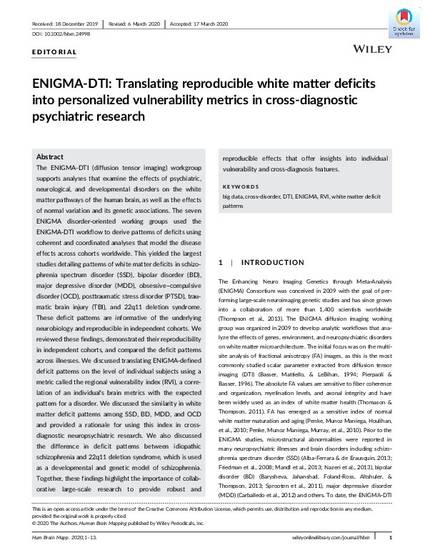
Article
ENIGMA-DTI: Translating reproducible white matter deficits into personalized vulnerability metrics in cross-diagnostic psychiatric research.
Human Brain Mapping
(2020)
Abstract
The ENIGMA‐DTI (diffusion tensor imaging) workgroup supports analyses that examine the effects of psychiatric, neurological, and developmental disorders on the white matter pathways of the human brain, as well as the effects of normal variation and its genetic associations. The seven ENIGMA disorder‐oriented working groups used the ENIGMA‐DTI workflow to derive patterns of deficits using coherent and coordinated analyses that model the disease effects across cohorts worldwide. This yielded the largest studies detailing patterns of white matter deficits in schizophrenia spectrum disorder (SSD), bipolar disorder (BD), major depressive disorder (MDD), obsessive–compulsive disorder (OCD), posttraumatic stress disorder (PTSD), traumatic brain injury (TBI), and 22q11 deletion syndrome. These deficit patterns are informative of the underlying neurobiology and reproducible in independent cohorts. We reviewed these findings, demonstrated their reproducibility in independent cohorts, and compared the deficit patterns across illnesses. We discussed translating ENIGMA‐defined deficit patterns on the level of individual subjects using a metric called the regional vulnerability index (RVI), a correlation of an individual's brain metrics with the expected pattern for a disorder. We discussed the similarity in white matter deficit patterns among SSD, BD, MDD, and OCD and provided a rationale for using this index in cross‐diagnostic neuropsychiatric research. We also discussed the difference in deficit patterns between idiopathic schizophrenia and 22q11 deletion syndrome, which is used as a developmental and genetic model of schizophrenia. Together, these findings highlight the importance of collaborative large‐scale research to provide robust and reproducible effects that offer insights into individual vulnerability and cross‐diagnosis features.
Disciplines
- Psychology and
- Psychiatry
Publication Date
April 16, 2020
DOI
10.1002/HBM.24998
Citation Information
Peter Kochunov, L. Elliot Hong, Emily L. Dennis, Rajendra A. Morey, et al.. "ENIGMA-DTI: Translating reproducible white matter deficits into personalized vulnerability metrics in cross-diagnostic psychiatric research." Human Brain Mapping (2020) Available at: http://works.bepress.com/tate-david/78/
Creative Commons license

This work is licensed under a Creative Commons CC_BY International License.
